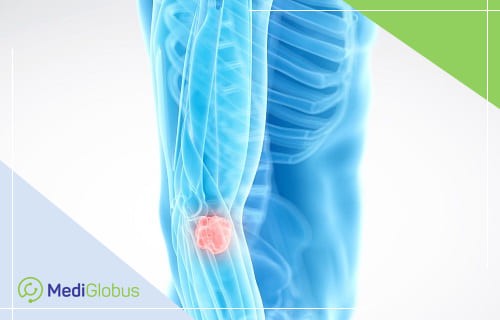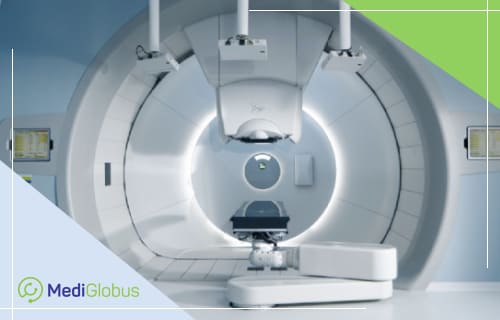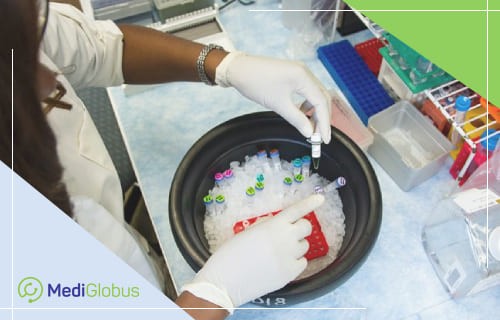Synovial sarcoma is one of the rarest cancers. It occurs in 2 people per 1,000,000. Most patients are between ages 15 and 35. It is slightly more common among men than among women.
You can learn more about modern methods of diagnostics and treatment of synovial sarcoma in foreign clinics from this article.
What is synovial sarcoma?

Synovial sarcoma, or malignant synovioma, is an oncological disease that affects the connective tissue. Most often, tumours grow from the muscles or tendons in arms and legs, especially around joints. However, they can also form in the tissues of the neck, head, abdomen or lungs.
The causes of the synovial sarcoma are not fully understood. It is well known that it is associated with non-inheritable genetic mutations. It has been suggested that exposure to toxic substances such as arsenic or vinyl chloride and radiation exposure may increase the risk of this type of cancer.
In the first stages of the disease, it can stay unnoticed. With the growth of the tumour, the patient gains different symptoms, depending on the location of the focus:
Synovial sarcoma of the arms or legs is most commonly seen in swelling of the affected limb. The patient may detect a slow-growing lump. If the tumour starts to press on nerves, numbness and pain may appear.
Synovial sarcoma of the neck and head also takes the form of a painful lump. Depending on its location, it may also cause breathing difficulties, swallowing or voice changes.
Sometimes patients mistake synovioma for arthritis.
Less than 10% of patients have metastases at the time of initial diagnosis. The risk of metastases is also higher in patients whose tumours are larger than 5 cm in diameter. Most often, cancer spreads into the lungs.
How is synovial sarcoma diagnosed?
If the doctor discovers signs of cancer during the examination, tests must be performed to confirm the diagnosis, which can determine the type of cancer and the exact location of the tumour. CT, MRI and sonography are imaging techniques that are also important when planning a tumour removal operation.
CT | Computer tomography is a method of examination, which is often used in cancer diagnostics. It consists in creating an image of human internal organs based on X-rays. The doctor can examine the necessary area through multiple slices, which increases the chance to detect malignancy compared to conventional X-rays. |
MRI | Magnetic resonance imaging uses magnetic fields to detect a tumour. Unlike CT, MRI is more effective at visualizing soft tissue and is more commonly used to examine muscle, ligament and vein tumours. |
Sonogram | The method of ultrasonic examination of the tumour. It is used more often if the tumour is located in the abdominal cavity. |
Biopsy | The main method of confirming the diagnosis of synovial sarcoma. The doctor extracts a sample of the tumour tissue for further laboratory analysis. The biopsy may be open (carried out through a small incision) or done with a special biopsy needle. The procedure is performed under local anaesthesia. |
Immunohistochemistry | It is a method of research, which is carried out on tumour tissue samples obtained from a biopsy. In the laboratory, tissue slices are dyed with special substances. The way they react to chemical reagents indicates the diagnostic characteristics of the tumour and influences the cancer treatment strategy. |
Genetic analysis | With this test, a doctor can detect a specific mutation characteristic of a synovioma. |
Synovial sarcoma treatment methods
The strategy for treating synovial sarcoma depends on many factors:
Size, stage and grade of the tumour;
Tumour locations;
The presence of metastases;
The age and health of the patient.
Synovial sarcoma removal
Surgery is the main and most effective method of synovioma therapy. During the procedure, a small amount of surrounding healthy tissue is removed together with the tumour. This is done so that no cancerous cells are left in the body, from which remission can subsequently develop.

However, the planning of operation largely depends on the location of the tumour. In some cases, the doctor can not completely remove the surrounding healthy tissue. It has to be left to preserve the function of the organ or body area.

Chemotherapy
Special chemicals that have toxic effects on cancer cells. In oncology, there are “chemotherapy protocols” – guidelines that specify which drugs should be prescribed to the patient depending on the type of cancer, its stage, age, etc. Often, doctors prescribe several drugs at the same time, which increases their total effectiveness. When drawing up a treatment plan, the doctor correlates the expected effectiveness of chemotherapy with the expected side effects.
Chemotherapy is often used in the treatment of synovial sarcoma, especially in late stages or when metastases are present. A course may be prescribed either after surgery (to destroy malignancy remainders) or before (to reduce the size of the tumour).
Radiotherapy
This is a method that uses high doses of X-rays to reduce or eliminate malignancies by damaging their DNA structure. Damaged cells can no longer divide and soon die. The effect of radiotherapy becomes visible a few days or weeks after the course begins.
Radiotherapy can be performed with the help of a special device, or through placing the radiation source inside the body, next to the tumour. In this case, the procedure is called brachytherapy.
Radiotherapy can be used together or instead of chemotherapy to destroy the malignant cells left after the operation. It is also used to reduce the size of the tumour before surgery. Such intervention can save more healthy tissue.

After treatment, the patient must be regularly checked with an oncologist to prevent relapse. As the tumour may develop asymptomatically at an early stage, a body CT scan is usually prescribed.
The prognosis for synovial sarcoma
Since synovioma is a very rare type of cancer, doctors do not have accurate data to give a precise prognosis. On average, the five-year survival rate is estimated at 50-60%. Many factors influence the efficacy of treatment, like the size, stage and differentiation of the tumour. Patients who have managed to completely remove the tumour surgically have better chances.
What new treatments are being developed for malignant synovioma?
Doctors in research institutes are developing therapeutic methods that would be more effective in treating synovial sarcoma. A T-cell therapy drug is planned to be released by 2022. This is a variant of immune therapy that uses the body’s cells, modified in the laboratory to attack and destroy sarcoma. Studies show that it is more effective than a standard course of treatment.
Other studies are testing the efficacy of existing immunotherapy drugs in combination with radiotherapy for synovial sarcoma.

What clinics treat synovioma abroad?
A synovial sarcoma is an aggressive form of cancer. The most reliable way of treatment is to contact a clinic that specializes in the treatment of sarcoma. Many foreign centres have departments where specialists from different fields – radiology, oncology, surgery, etc. – have extensive experience in sarcoma treatment.
Among such centres we can mention:
Liv Hospital Network (Turkey);
The network of Memorial Clinics (Turkey);
Quironsalud Hospitals Group (Spain);
Rechts der Isar Clinic (Germany) ;
Soon Chun Hyang Medical Center (Korea);
Anam University Hospital (Korea);
Resume
Synovial sarcoma is a rare type of soft tissue cancer. The main danger of the disease is that it is asymptomatic in its early stages.
Treatment of the synovioma involves surgical removal of the tumour, which is often accompanied by a course of chemotherapy or radiotherapy.
The effectiveness of the treatment depends on many factors, primarily the size and stage of the tumour, its location, degree of differentiation, as well as the age and health of the patient.
Treatment of synovial sarcoma is available at cancer departments of clinics in Turkey, Spain, Germany, South Korea and China.
To learn more about synovial sarcoma or to get a consultation on cancer treatment abroad, leave your application on the Mediglobus website. Our coordinating doctors will call you back at your phone number and answer all your questions.





